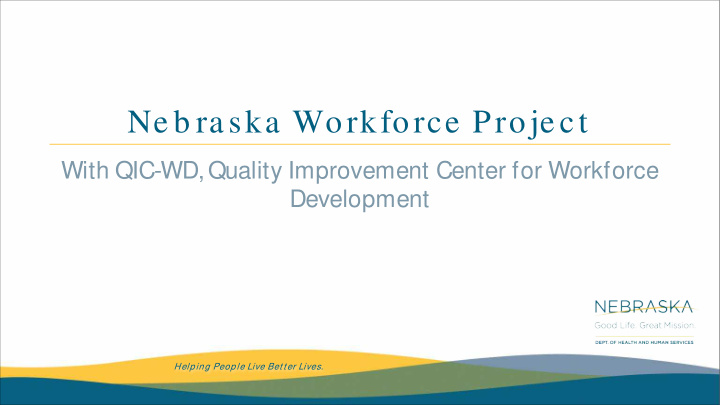



Ne b ra ska Workforce Proje ct With QIC-WD, Quality Improvement Center for Workforce Development Helping People Live Bet ter Lives.
Ne b ra ska Goa ls • Keeping Families Together • Prevent and Reduce the Number of Children in Out-of-Home Placement • Retention QIC-WD research project Goals Learn from the experts on the QIC-WD team some tools, strategies and best practices that we will be able to utilize in the future. Increase Retention of the CFSS worker by increased J ob Satisfaction. Comply with statutory requirements for caseload standards. Improve our service to the children and families that we serve. Helping People Live Bet ter Lives.
Ba ckgrou n d The Children and Family Services Division in the Nebraska Department of Health and Human Services (DHHS) at the start of this research project had an annual turnover rate for Children and Family Services Specialists (CFSS) of about 32 percent, which includes both those who left the agency and those who found another job in the agency. High turnover is just one example of costly workforce issues than can negatively impact vulnerable children. DHHS was selected as one of eight sites to partner with the Quality Improvement Center for Workforce Development (QIC-WD) to strengthen their workforce. Helping People Live Bet ter Lives.
Se le cte d Ch ild We lfa re Syste m s Sel elec ected ed child ild welf lfare s systems in inclu lude : Nebraska DHHS, Division of Child and Family Services Division of Milwaukee (WI) Child Protective Services Eastern Band of Cherokee Indians Louisiana Department Of Children and Family Services Ohio Department of J ob and Family Oklahoma Department of Human Services Virginia Department of Social Services Washington Department of Social and Health Services Helping People Live Bet ter Lives.
Ne b ra ska Core Te a m • Mike Puls – SAA in NSA • Jamie Maxwell – OT CFSS in NSA • Jennifer Runge – Administrator in SESA • Doug Beran – Data Coordinator • Lana Sayre – Supervisor in ESA • Sharon Kruse – Site Implementation Manager • Jade Yockey – IA CFSS in CSA • Matt Wallen – Team Sponsor • Mary Potmesil – IA CFSS in ESA • Theresa Hill – Team Sponsor • Jennifer Walker – OT CFSS in WSA • Pepper Meyer – Central Office • Stephanie Vensky – OT CFSS in SESA Helping People Live Bet ter Lives.
QIC-WD Proce ss Explor orat ion on Inst al allat at ion Full ll Im plem em en ent at at ion Init it ia ial Im plem em en ent at at ion Helping People Live Bet ter Lives.
Exp lora tion : Ove rview 1. Identify the problem we want to solve and what outcome(s) we want to target 2. Identify the population we intend to target 3. Conduct root cause analysis to identify potential causes 4. Identify barriers or facilitators to addressing the problem 5. Develop a theory of change 6. Assess and select a workforce strategy or intervention 7. Assess implementation supports 8. Develop an implementation plan. Helping People Live Bet ter Lives.
Ne b ra ska ’s Exp lora tion Ph a se Reviewed HR data and processes related to recruitment, selection and turnover of CFS Specialists (CFSS). Completed 3 surveys 1. Organizational Social Context measure (OSC) designed to assess an organization’s culture and climate and normed using data from 81 child welfare agencies across the country 2. Secondary Traumatic Stress scale (STS), which measures the degree to which staff are experiencing symptoms of secondary trauma as a result of their work with clients 3. Evaluation readiness, which measures attitudes and perceptions around implementing change Helping People Live Bet ter Lives.
Ne b ra ska ’s Exp lora tion Ph a se Key findings In 2017, there were about 380 CFSS workers (this includes CFSS & Hotline). Among current employees, the median tenure is 2.7 years. Among those who quit in 2017, it typically happened within the first 2 years. The turnover rate in 2017 was about 28% . More than 3,500 people applied for a CFSS position in 2017. The candidate pools have helped to fill open positions quickly, but we can improve upon our hiring practices to screen for the “right” candidates. About ¼ of our CFSS were in training in February 2018, which impacts workload across the agency. We examined how caseloads are distributed across service areas and how that changes over time. Survey results indicate that our CFSS do not feel engaged with children, families, and community partners (relative to what caseworkers in other child welfare agencies report). Another survey found that nearly half of our CFSS experienced symptoms of secondary traumatic stress often or very often. Helping People Live Bet ter Lives.
Ne b ra ska ’s Exp lora tion Ph a se Our Root Cause Analysis narrowed us to the following four areas: 1. Staff are leaving due to feeling disrespected from strained professional relationships with the courts 2. Secondary Traumatic Stress 3. Workers are leaving due to lack of supervisory support 4. Depersonalization Helping People Live Bet ter Lives.
Ne b ra ska ’s Exp lora tion Ph a se Next Steps: 1. Assess and select a workforce strategy or intervention 2. Assess implementation supports 3. Develop an implementation plan Helping People Live Bet ter Lives.
Recommend
More recommend